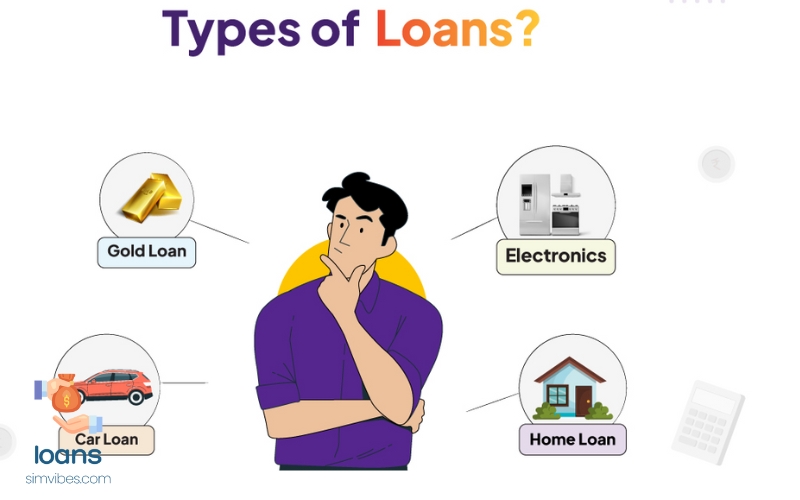In the financial world, loans play an important role in providing financial resources to individuals, businesses and organizations. From short-term loans to long-term loans, each type has its own characteristics and purposes. Below, we will explore the most common types of loans, helping you better understand your borrowing options and how they work.
1. CONSUMER LOANS
Consumer loans are one of the most popular forms of loan today, for individuals with financial needs to serve consumer purposes such as shopping, traveling, or paying for unexpected expenses. These loan usually do not require collateral, so the interest rate is often higher than other types of loans. Consumer loans can be granted in the form of unsecured loans, so the borrower only needs to provide personal information and financial capacity to prove the ability to repay the debt.

The special thing about consumer loan is the flexibility in using capital. Although the purpose of the loan is not required to be clearly defined, the borrower needs to prove his ability to repay the debt through factors such as income, credit history and financial capacity.
2. HOME LOANS
Home loans are one of the most popular and important forms of long-term loan in the financial lives of many people. This loan is mainly used to buy real estate, and the borrower must mortgage the property itself (the house) to secure the loan. Home loans can be divided into several types, including fixed-rate home loan, variable-rate loan, or government-backed loans (such as mortgages with preferential interest rates).
Home loan interest rates are often much lower than other types of loan because the loan is secured by assets. However, because the loan value is large and the loan term is long (usually from 10 to 30 years), borrowers need to have a solid financial plan to ensure the ability to repay the loan.
3. AUTO LOANS
An auto loan is a loan used to buy a car, with a similar borrowing method to a home loan. The borrower will mortgage the new or used car he or she buys to secure the loan. This loan has a shorter loan term than a home loan, usually ranging from 3 to 7 years, depending on the value of the car and the borrower’s financial capacity.
Car loan interest rates are typically lower than consumer loan, but still higher than home loans. Although not long-term loan, car loans still require borrowers to have stable financial ability to repay the loan every month, avoiding the risk of losing assets due to default.
4. STUDENT LOANS
Student loan are an essential financial tool for those who want to continue their studies at college, university or graduate school but cannot afford the tuition fees. These loan are usually issued by the government or private credit institutions, and have easier loan conditions than other types of loans.
Student loan often have low interest rates and flexible repayment terms, but have strict requirements on the ability to repay after the borrower graduates and has a stable job. One thing to note is that, although student loan are beneficial in terms of interest rates and repayment periods, if not repaid on time, these debts can affect the borrower’s credit score in the future.
5. BUSINESS LOANS
Business loans are loans granted to businesses to support business operations, product development or expansion. These loan can come from banks, credit institutions or investors. Business loans often require collateral or a detailed business plan to demonstrate the feasibility of the loan project.
There are many types of business loan, including short-term loan to cover daily operating expenses, long-term loan to expand facilities or loan for research and development projects. Business loan interest rates depend on many factors such as business size, financial situation, business industry and the borrower’s reputation.
6. CASH LOANS
Cash loan are a very popular type of loan for people who need money urgently to solve urgent financial situations. These loans can be granted without collateral, but the interest rate is usually very high. This is a short-term loan, the repayment period can last only a few weeks or a few months.
Although cash loans help borrowers quickly solve immediate financial problems, borrowers need to pay special attention to their ability to repay the loan because otherwise, the interest rate will significantly increase the amount to be paid. Usually, this loan is granted based on the borrower’s personal credit and ability to prove payment ability.
7. CREDIT CARD LOANS
Credit card loan are a very popular and convenient form of loan, allowing borrowers to spend first and pay later. This is a type of loan without collateral, and the borrower only needs a credit card issued by a bank or credit institution. Credit card loan can be used for many different purposes, from purchasing goods to paying service fees.
However, if the loan is not paid on time, the borrower will have to pay a very high interest rate, often ranging from 15% to 30% per year, depending on the terms of the card. Therefore, although credit card loan are flexible and convenient, borrowers need to manage their spending and repay the loan on time to avoid additional fees.
CONCLUSION
Depending on financial needs and purposes, each type of loan will have its own advantages and limitations. Understanding the common types of loans will help you choose the loan form that best suits your financial capacity and needs. Whether it is a consumer loan, a home loan or a business loan, each type has a direct impact on your future financial ability. Therefore, it is extremely important to consider carefully before borrowing and ensure the ability to repay on time.
